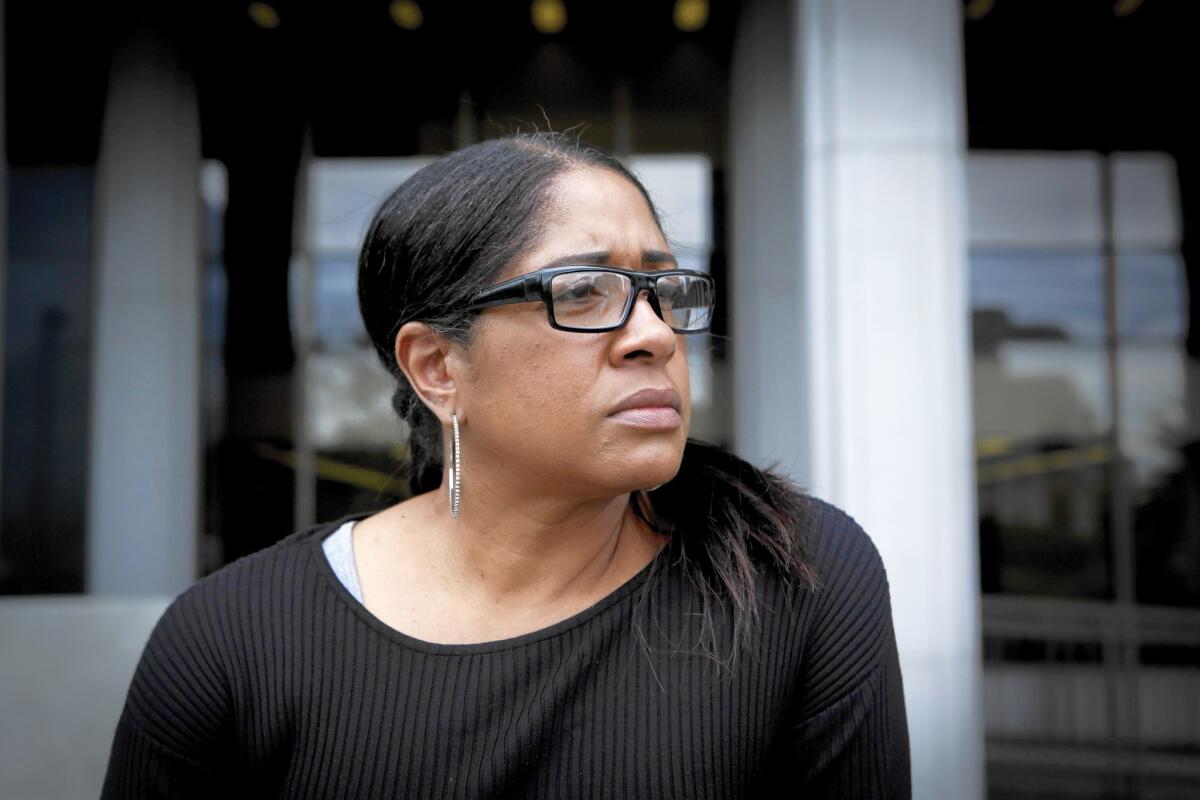LAPD believes ‘Grim Sleeper’ serial killer never actually slept

- Share via
Vivian Williams had long given up hope that her sister’s slaying would be solved when she flipped on her television and saw news about a serial killer nicknamed the Grim Sleeper.
As she watched Los Angeles police detectives raid a green house on 81st Street, a sickening feeling overcame her. Williams realized she had been to the home many times, dropping off her sister, Georgia Mae Thomas, to visit a boyfriend, Lonnie.
“He did it, he did it!” she yelled to her husband. “I know he did it.”
That man, Lonnie David Franklin Jr., was convicted Thursday in the killings of nine women and a 15-year-old girl.
Though Thomas was not included in that group of victims, prosecutors are preparing to present her case and those of four others also believed murdered by Franklin in the trial’s penalty phase, set to begin Thursday.
In doing so, authorities are challenging a central narrative of one of L.A.’s most notorious serial killers, whose first murder took place in 1985 and last known case occurred in 2007. Franklin was dubbed the Grim Sleeper for an apparent gap of more than 14 years between killings, from 1988 to 2002.
Authorities believe the Grim Sleeper never really slept, and that Thomas’ slaying in 2000 helps prove that.
“I don’t think he stopped killing,” said LAPD Det. Daryn Dupree, the last remaining detective who worked on the task force that arrested Franklin.
In all, investigators believe Franklin is responsible for at least 25 slayings, including 11 that took place during the supposed dormant period that led to his sobriquet.
The five victims that prosecutors will present in the penalty phase bring to the forefront strong cases that Franklin was not charged with.
The cases were connected to Franklin after he was charged with the other murders, and prosecutors said additional charges would have forced more delays and not increased his possible punishment because he already was facing the death penalty. The victims’ families supported the decision not to prosecute the cases.
The five women shared much in common with the other victims in both life and death.
They were all young, black and leading difficult lives in South L.A. They struggled with addiction, and some resorted to prostitution to support their habit.
The killings were carried out with Franklin’s distinctive modus operandi, prosecutors say. The women were shot in the chest and discarded amid the filth in alleyways and dumpsters.
Thomas, 43, was shot twice in the chest and dumped in an industrial yard surrounded by garbage near where other victims had been discovered. Dupree said Franklin’s DNA was found on her body. Ballistics tests, he said, showed she was killed by a .25-caliber handgun that police recovered from Franklin’s home.
Inez Warren, 28, was found in a Gramercy Park alleyway with a gunshot wound to the chest. Sharon Dismuke, 21, was shot twice in the chest and left in an abandoned gas station with a rag stuffed in her mouth.
Ayellah Marshall, 18, vanished in 2006. Rolenia Morris, 31, a mother of two, disappeared in 2005. Their bodies have never been found.
Investigators found more than 1,000 photos and hundreds of hours of video in Franklin’s house, showing women, many of them nude and in sexually graphic poses, some seemingly unconscious.
Marshall’s Hawthorne High School ID card and a photograph of Morris, along with her driver’s license, were found inside a garage refrigerator stuffed with a morbid cache of items. Prosecutors called it Franklin’s “trophy case.”
In the penalty phase beginning this week, the jury will consider whether to sentence Franklin to death or to life in prison without parole.
The families of the victims will address the jury about the loss of their mothers, daughters and sisters.
Williams said she is still angry and has waited years to stand up to Franklin. During the trial, she said they made eye contact as he walked to the defense table. “That’s right. I remember you and I know you remember Georgia,” she recalled thinking. “You know you did it, and I know you did it.”
She looks forward to again confronting the man who would smile and wave at her each time she left her sister with him.
“I’d like to remind him — all those times that I brought her to you,” she said. “You waved at me — and then you killed her.”
::

Alicia Alexander, 18, was the seventh victim of the man authorities dubbed the Grim Sleeper serial killer. Her family has attended nearly every court hearing.
The chance to face Franklin, other family members say, will allow them to defend these women who deserved a better fate.
Tina Saunders and her older sister, Sharon Dismuke, fought as only sisters could. Dismuke was strong-willed but sensitive. A tomboy who was never seen in a dress — only her jeans, a T-shirt and white Chuck Taylor All-Star sneakers.
Her tough exterior hid her troubles. But despite her frailties, Dismuke was a fierce guardian to her younger sister.
When she was 15, Tina’s boyfriend left a mark on her leg while horseplaying. Dismuke was not pleased, Saunders recalled.
Her older sister stormed over to the boy’s house.
“She went over there and straightened him out,” Saunders said with a laugh. “He came back and apologized.”
Dismuke’s addictions consumed her, but they were mostly hidden. Saunders remembers her sister grabbing her by her shirt one evening, imploring her to never do drugs.
“I was naive, but I can see now that she struggled,” Saunders said. “But she always tried to protect me.”
Their last conversation was about how excited they were to soon be aunts. Dismuke did not live long enough to meet her nieces and nephews, Saunders said.
“I just believed that any day she would come walking back up on that porch,” she said.
In 2010, Saunders wondered if the Grim Sleeper case had anything to do with her sister. But after nearly 30 years, she’d given up hope.
A few months later, an LAPD detective called to say that a gun found during a search of Franklin’s home — which was used to kill victim Janecia Peters — was also used to kill Dismuke.
Decades of indifference from authorities allowed Franklin to kill freely, Saunders said. Now, she refuses to allow her sister to go unspoken for and will tell of a promising life cut short.
“We don’t know what her life would have been — she wasn’t given a chance,” she said.
Donte Cannon, 22, remembers his mother, Rolenia Morris, as someone who had little but was willing to give it all to her children.
She stretched what little money she had to take him and his sister to Six Flags. On weekends, she would sit in a beach chair as Cannon and his sister splashed around the swimming pool at Jesse Owens park.
“I’m a mama’s boy,” he said. “We were struggling my whole life, but whatever I wanted to do as a kid, she was with it.”
At times, they bounced from homeless shelter to homeless shelter. She wanted him to go live with his father, to have a more stable life, but he refused to leave her side. Eventually, it became too difficult to care for Cannon, and she sent him to live in Rialto.
But his mother called every day to check up on him. To hear her voice each day and know she was doing OK calmed him.
“Then she stopped calling,” Cannon said.
Relatives told him she was out of touch because she was getting her life together. But he felt abandoned and worried. He lashed out against the rest of his family.
After investigators tied her disappearance to Franklin, Cannon was still haunted: How could such a strong woman be hurt that way?
Cannon found that the guilty verdict brought no solace, and a death sentence would do little to comfort him. “There won’t ever be any closure,” he said. “There wasn’t even a funeral.”
Cannon now has a 3-year-old son of his own, and he tries to match the devotion his mother showed to him, holding out hope that she might still be alive.
“I just want to know where my mama’s body is,” he said. “I know she’s probably gone, but I just can’t accept it.”
::
The penalty phase is expected to last a month, but investigators believe the mystery surrounding the Grim Sleeper killer will persist.
After the troubling discovery of Franklin’s trove of photographs, detectives spent months trying to identify the women.
Of the more than 1,000 photographs, investigators released 180, of women they were unable to identify. They were eventually able to identify all but 35
Over the years, Dupree, the LAPD detective, has fielded hundreds of calls, chasing down leads to see if another woman should be added to Franklin’s tally.
He receives calls nearly every day on the case. He suspects they will continue for years.
Twitter: @sjceasar
ALSO
Police chase ends in Ontario with motorist jumping to his death
Uber conquered taxis. Now it’s going after everything else
In North Korea and trapped in a real-life version of ‘Waiting for Godot’
More to Read
Sign up for Essential California
The most important California stories and recommendations in your inbox every morning.
You may occasionally receive promotional content from the Los Angeles Times.














